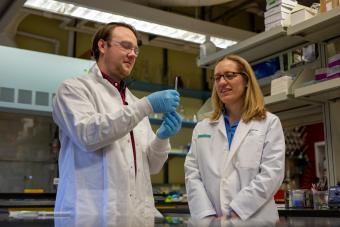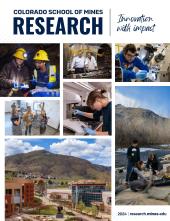From concept to startup: How Mines helps turn innovative research into real-world companies
For companies like GelSana Therapeutics, Mines is helping solutions developed in the lab find a path to market


As Melissa Krebs was in the lab working on the biopolymer that would become Cleragel, it quickly became clear that the stretchable wound dressing, which improves healing in chronic wounds such as diabetic ulcers, was working so well that she could see a clear path throughFDA submission, approval and beyond.
“We’re trying to solve a big problem that needs a solution, and maybe this is the time to push it all the way through from the academic lab and into the commercial side,” recalled Krebs, Mines associate professor of chemical and biological engineering and founder of GelSana Therapeutics. “We had really good data and a really clear path to market.”
Diabetic ulcers are difficult to heal and lead to 80 percent of the non-traumatic limb amputations in the U.S. A solution that lets these chronic wounds heal will literally save limbs, but first, this novel gel needed to move beyond the lab and into a company that could take it all the way to market.
Fortunately, when Krebs reached out to the Mines Office of Research andTechnology Transfer, she found robust resources already in place to aid her in the next steps, starting with moving her intellectual property from the university to her new company, GelSana, and finding the right partners to fund and advise the company along the way. Mines connected her with Innosphere, a venture capital firm in Fort Collins,Colorado with a history of launching tech and science startups by partnering with university technology transfer offices.
“At the very beginning of company creation, the major goals were, transfer your intellectual property from the university to a company, then find the lab and office space,” Krebs said. “You have these small, discreet steps to building the company. I took an entire sabbatical year and was able to focus full-time on GelSana. We did a seed round, I brought on a full-time employee and we started manufacturing.
As Krebs was going through this process, Mines was launching its own new endeavor: an entrepreneurship and innovation (E&I) ecosystem to support a state-of-the-art network of facilities, programs, resources and business connections for the Mines community to expand their reach and impact in the world. This included development of the Mines Venture Fund I, which invests in startups from the Mines community, including faculty, students, alumni and research partners.
“We’ve been primarily funded through Innosphere and angel investors, and then we wanted to start a priced-seed round,” Krebs said. “That was when the Mines Venture Fund was formed, and that was perfect timing, because they’re able to fund in seed rounds, so they were able to participate in our first priced round for the company.”
In February 2024, GelSana became the first recipient of investment funding from the Mines Venture Fund I, and though Mines already had resources in place for researchers like Krebs, the school’s recent investments in supporting innovators in the Mines community has provided even more opportunities. Mines has built more funding, partnership and entrepreneurship support for the E&I ecosystem, including resources specifically for those looking to launch commercial products and services, such as venture funding opportunities, startup support, mentorship and more supported by the Beck Venture Center on campus. Many of the E&I resources are open not just to faculty, but students and alumni as well as partners—anyone who is connected to the Mines community.
The funding from the Mines Venture Fund I is especially welcome as GelSana approaches the next hurdle on the way to FDA clearance for Cleragel. “With this priced round, the milestone is to get to FDA registration,” Krebs said. “We are almost there—we have a clear sight to it. The regulatory hurdles in medicine are definitely more significant, as they should be, and it ultimately means you need more capital to get your product to market.”
As GelSana works toward this goal, the company is also focused on developing hydrogel-based wound dressing products that will have a broader reach, including a gel that can deliver timed-release medication.
Krebs said Mines’ reputation and resources have made it a great environment for doing innovative research—and becoming a startup founder. “We attract top talent. As faculty, you have a lab of really strong, motivated graduate students and post-docs that can really push the research forward,” she said. “Being an engineering school, we have really good resources from a materials standpoint, and right down the road is a medical school, which is so important for us. And now, we have that strong engineering and a strong entrepreneurial focus.”



